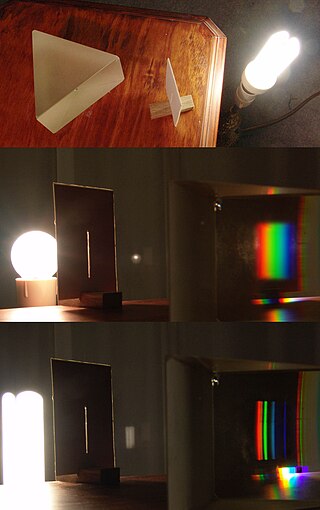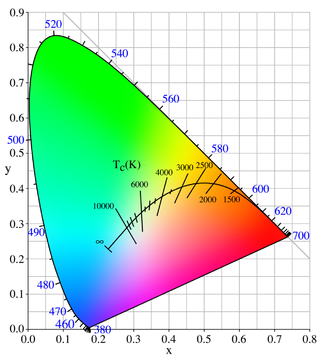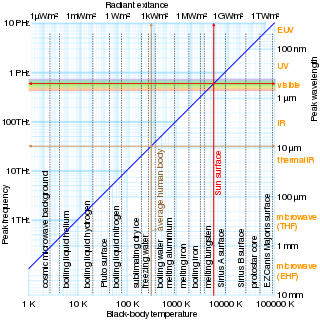
In colorimetry, metamerism is a perceived matching of colors with different (nonmatching) spectral power distributions. Colors that match this way are called metamers.

The International Commission on Illumination is the international authority on light, illumination, colour, and colour spaces. It was established in 1913 as a successor to the Commission Internationale de Photométrie, which was founded in 1900, and is today based in Vienna, Austria.
Colorimetry or Colourimetry is "the science and technology used to quantify and describe physically the human color perception". It is similar to spectrophotometry, but is distinguished by its interest in reducing spectra to the physical correlates of color perception, most often the CIE 1931 XYZ color space tristimulus values and related quantities.

In color reproduction and colorimetry, a gamut, or color gamut, is a convex set containing the colors that can be accurately represented, i.e. reproduced by an output device or measured by an input device. Devices with a larger gamut can represent more colors. Similarly, gamut may also refer to the colors within a defined color space, which is not linked to a specific device. A trichromatic gamut is often visualized as a color triangle. A less common usage defines gamut as the subset of colors contained within an image, scene or video.
The RGB chromaticity space, two dimensions of the normalized RGB space, is a chromaticity space, a two-dimensional color space in which there is no intensity information.

In color science, the dominant wavelength is a method of characterizing a color's hue. Along with purity, it makes up one half of the Helmholtz coordinates. A color's dominant wavelength is the wavelength of monochromatic spectral light that evokes an identical perception of hue.

A color rendering index (CRI) is a quantitative measure of the ability of a light source to reveal the colors of various objects faithfully in comparison with a natural or standard light source. Light sources with a high CRI are desirable in color-critical applications such as neonatal care and art restoration.

In physics and color science, the Planckian locus or black body locus is the path or locus that the color of an incandescent black body would take in a particular chromaticity space as the blackbody temperature changes. It goes from deep red at low temperatures through orange, yellowish, white, and finally bluish white at very high temperatures.

The correlated color temperature is defined as "the temperature of the Planckian radiator whose perceived color most closely resembles that of a given stimulus at the same brightness and under specified viewing conditions."

The CIE 1931 color spaces are the first defined quantitative links between distributions of wavelengths in the electromagnetic visible spectrum, and physiologically perceived colors in human color vision. The mathematical relationships that define these color spaces are essential tools for color management, important when dealing with color inks, illuminated displays, and recording devices such as digital cameras. The system was designed in 1931 by the "Commission Internationale de l'éclairage", known in English as the International Commission on Illumination.

LMS, is a color space which represents the response of the three types of cones of the human eye, named for their responsivity (sensitivity) peaks at long, medium, and short wavelengths.

A standard illuminant is a theoretical source of visible light with a spectral power distribution that is published. Standard illuminants provide a basis for comparing images or colors recorded under different lighting.
Henry Hemmendinger was an American color scientist.

David Lewis MacAdam was an American physicist and color scientist who made important contributions to color science and technology in the fields of colorimetry, color discrimination, color photography and television, and color order.

The CIE 1960 color space ("CIE 1960 UCS", variously expanded Uniform Color Space, Uniform Color Scale, Uniform Chromaticity Scale, Uniform Chromaticity Space) is another name for the (u, v) chromaticity space devised by David MacAdam.
The CIE 1964 (U*, V*, W*) color space, also known as CIEUVW, is based on the CIE 1960 UCS:

Deane Brewster Judd was an American physicist who made important contributions to the fields of colorimetry, color discrimination, color order, and color vision.

In physical and analytical chemistry, colorimetry or colourimetry is a technique used to determine the concentration of colored compounds in solution. A colorimeter is a device used to test the magnitude of a solution by measuring its absorbance of a specific wavelength of light.
The color rendering of a light source refers to its ability to reveal the colors of various objects faithfully in comparison with an ideal or natural light source. Light sources with good color rendering are desirable in color-critical applications such as neonatal care and art restoration. It is defined by the International Commission on Illumination (CIE) as follows:
Effect of an illuminant on the color appearance of objects by conscious or subconscious comparison with their color appearance under a reference illuminant.

Günter Wolfgang Wyszecki was a German-Canadian physicist who made important contributions to the fields of colorimetry, color discrimination, color order, and color vision.

















